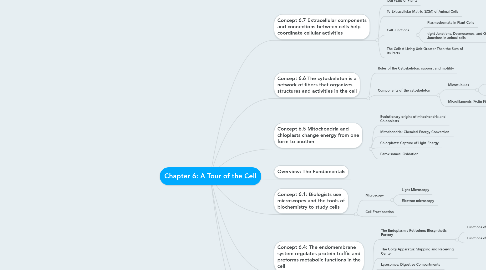Chapter 6: A Tour of the Cell
создатель Carolyn Grace


1. Concept 6.7 Extracellular components and connections between cells help coordinate cellular activities
1.1. Cell Walls of Plants
1.2. Te Extracellular Matrix (ECM) of Animal Cells
1.3. Cell Junctions
1.3.1. Plasmodesmata in Plant Cells
1.3.2. tight Junctions, Desmosomes, and Gap Junctions in animal cells
1.4. The Cell: A Living Unit Greater Than the Sum of Its Parts
2. Concept 6.6 The cytoskeleton is a network of fibers that organizes structures and activities in the cell
2.1. Roles of the Cytoskeleton: support and motility
2.2. Components of the cytoskeleton
2.2.1. Microtubules
2.2.1.1. Centrosomes and Centrioles
2.2.1.2. Celia and Flagella
2.2.2. Microfilaments (Actin Filaments)
3. Concept 6.5 Mitochondria and chloplasts change energy from one form to another
3.1. Evolutionary origins of mitochondria and Chlopolasts
3.2. Mitochondria: Chemical Energy Conversion
3.3. Chlorplasts: Capture of Light Energy
3.4. Peroxisomes: Oxidation
4. Overview: The Fundamentals
5. Concept 6.1: Biologists use microscopes and the tools of biochemistry to study cells
5.1. Microscopy
5.1.1. Light Microscopy
5.1.2. Electron microscopy
5.2. Cell Fractionation
6. Concept 6.4: The endomembrane system regulates protein traffic and preforms metabolic functions in the cell
6.1. The Endoplasmic Reticulum: Biosynthetic Factory
6.1.1. Functions of the Smooth ER
6.1.2. Functions of the Rough ER
